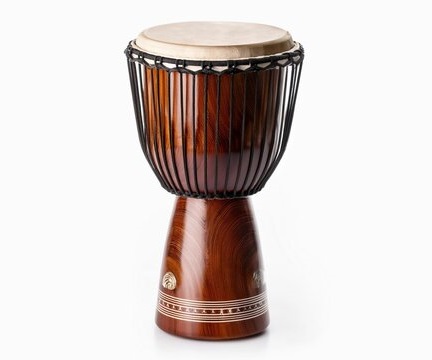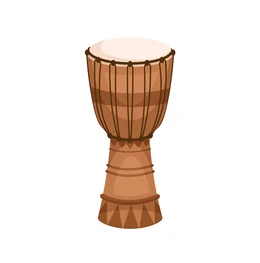Goblet drum
Percussions
Africa
Between 1001 and 1900 AD
The goblet drum, also known as the darbuka, doumbek, or tarabuka, is a distinctive percussion instrument characterized by its goblet-shaped body and a single drumhead.
This instrument belongs to the membranophone family, meaning it produces sound primarily through the vibration of a stretched membrane. Goblet drums are widely recognized for their versatility and are integral to various musical traditions across the Middle East, North Africa, and parts of Europe. Goblet drums are classified as membranophones, which are instruments that generate sound through the vibration of a skin or membrane stretched over a frame. The goblet shape not only contributes to its aesthetic appeal but also enhances its acoustic properties, allowing for a rich tonal range. Common types of goblet drums include the darbuka, djembe, and tonbak, each with unique characteristics and playing techniques.
History
The history of the goblet drum dates back several centuries, with origins traced predominantly to the Middle East and North Africa. The earliest forms of these instruments can be found in ancient civilizations, particularly in Egypt and Mesopotamia, around the 12th century. Over time, variations of the goblet drum spread across different continents, adapting to local musical styles and cultural influences. By the 20th century, the goblet drum had gained global recognition, becoming a staple in various music genres.
Goblet drums, also known as “Djembe” in their most famous form, have a rich history rooted in the cultures of West Africa. These drums are characterized by their goblet-shaped, single-piece wooden bodies and their distinct, wide, and shallow drumheads made from animal skin, traditionally from goats. The drum was central to many social, spiritual, and ceremonial events, including weddings, harvest celebrations, and rites of passage, where its rhythms were believed to communicate with ancestral spirits. Historically, goblet drums were not only used in music but also played a vital role in the oral traditions of African communities. Storytellers, griots, and drummers would accompany their narratives with the rhythm of the drum to emphasize the meaning of the tale or to signal particular events. Over time, the popularity of the goblet drum spread throughout West Africa and beyond, becoming a symbol of cultural identity. The rise of the Djembe in modern times, particularly after it was introduced to Western audiences in the 20th century, has led to its use in a variety of global music genres and cultural expressions, making it one of the most well-known and widely played percussion instruments in the world today.
Construction
Goblet drums are typically constructed from materials such as wood, clay, or metal. The body is designed in a goblet shape, tapering from a wider base to a narrower top. This design is not only visually striking but also acoustically effective. The drumhead is traditionally made from animal skin (such as goat or cowhide) but can also be crafted from synthetic materials for durability and weather resistance. The construction process involves shaping the body and securely attaching the drumhead, ensuring optimal sound quality.
Types
There are several notable types of goblet drums:Darbuka: Originating from the Middle East, this drum is known for its sharp tones and is often used in folk music.
Djembe: A West African drum that features a wide tonal range and is traditionally played with bare hands.
Tonbak: A Persian goblet drum that produces deep bass tones and is commonly used in classical Persian music.
Doumbek: Similar to the darbuka but often made from ceramic or metal; it has become popular in various world music genres.
Features and Sound Production
The goblet drum, commonly referred to as the darbuka or doumbek, is a single-headed membranophone characterized by its distinctive goblet-shaped body. This design contributes to its unique sound production, which is integral to various musical traditions across the Middle East, North Africa, and beyond. The goblet drum typically produces three primary sounds: the “Dum,” a deep bass tone created by striking the center of the drumhead; the “Tak,” a higher-pitched sound produced by hitting the edge of the head with fingertips; and the “Pa” or “Sak,” a muted sound achieved by resting the hand on the drumhead. Players often utilize intricate techniques such as rolls, snaps, and slaps to embellish rhythms, making the goblet drum a versatile instrument in both traditional and contemporary music.
Sound production in goblet drums occurs when the player strikes the drumhead with their hands or mallets. The tension of the membrane affects the pitch; tighter membranes produce higher pitches while looser ones yield lower tones. Players often utilize different striking techniques to create a range of sounds:
- Dum: A deep bass sound produced by hitting the center of the drumhead.
- Tak: A higher-pitched tone created by striking near the edge of the drumhead.
The combination of these sounds allows for intricate rhythms and patterns that are essential in many musical styles.
Playing Methods
Playing methods for goblet drums vary depending on regional styles and personal preferences. Common techniques include:Hand Techniques: Players often use their palms and fingers to strike different areas of the drumhead for varied tones.
Mallets: Some players prefer using mallets for more pronounced sounds.
Rhythmic Patterns: Goblet drumming often involves complex rhythmic patterns that can be improvised or learned through traditional methods.
In ensemble settings, goblet drums provide rhythmic support while complementing other instruments.
Roles in Music
In terms of its role in music, the goblet drum serves as a foundational element in many cultural contexts. It is prominently featured in folk music, dance, and celebratory events, often providing the rhythmic backbone that drives performances. In Egyptian Shaabi music, for instance, it is considered a national symbol and plays a crucial role in creating lively atmospheres during festivities. The goblet drum also finds its place in various ensemble settings, where it complements other instruments and enhances the overall texture of the music. Its adaptability allows it to be used in diverse genres, from classical compositions to modern fusion styles, making it an essential instrument for musicians seeking to connect with rich cultural heritages while exploring new musical landscapes.
FAQ
What is the origin of the Goblet drum?
The Goblet drum, also known as the darbuka or doumbek, originated in the Middle East and North Africa. It has ancient roots dating back over 5,000 years, commonly associated with Egyptian, Turkish, and Arabic cultures. The drum was traditionally used in both folk and ceremonial music. Its unique goblet shape distinguishes it from other hand drums.
What kind of music is played on the Goblet drum?
The Goblet drum is versatile and is used in a wide variety of musical genres. It is often featured in Middle Eastern, North African, and Balkan music, especially in folk dances and celebrations. It also appears in contemporary fusion music. The rhythms played on the drum are lively and syncopated, providing a strong rhythmic foundation.
What are the different types of Goblet drums?
There are several variations of the Goblet drum, with the darbuka being the most common. Other types include the doumbek, goblet-shaped drums with different tuning systems. Some drums have a single head, while others have two, and they vary in size and material, such as ceramic, wood, or metal. Each type produces distinct tones and timbres.
 Links
Links
References
Other Instrument
Categories



















